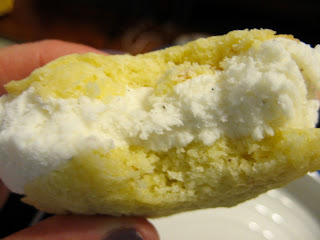 |
| Shrewsbury Cakes for as long as the eye can see. |
Shrewsbury Cakes are a traditional English biscuit named for the town of Shrewsbury, the county seat in Shropshire. The earliest written recipe dates to 1621, and results in a dessert that is similar to a traditional shortbread and flavored using nutmeg and rosewater. Interestingly, the recipe I used, from the 1796 American Cookery by Amelia Simmons (for those of you just joining in), is unlike the traditional recipe in a few ways. Most importantly, it calls for the addition of whole eggs. Traditionally, shortbread is made from only three ingredients: butter, flour, and sugar. So the addition of whole eggs into that mix makes my Shrewsbury Cakes quite unlike the original. Amelia also differs from the traditional recipe in her choice of flavorings. Though many of her recipes call for rosewater, implying that this flavoring of the traditional Cake was readily available to early Americans, her Shrewsbury Cakes recipe instead uses mace. Though related to nutmeg, mace has a decidedly different flavor to my mind, so it's interesting to me that her recipe uses the one over the other. I mean, I like the mace, don't get me wrong, but I think the nutmeg would work well, too. Amelia most likely had a practical reason for the substitution: due to the Dutch monopoly on nutmeg, mace would have been much more affordable and likely easier to come by.*
The other interesting aspect of Amelia Simmons's Shrewsbury Cake recipe is that its butter to flour ratio is remarkably different from many of the more modern recipes, which have more flour in them to the same amount of butter. However, her recipe is very similar to those currently served in Colonial Williamsburg, which are made from a recipe dating to 1808, so maybe Amelia knew what she was talking about after all. Taken together, though, the substitution of mace for nutmeg and the scant amount of flour suggests that Amelia's recipe represents a more frugal version of the original, living up to the promise in her title, to adapt recipes to 'this country and all grades of life.'
In the States, First Lady Louisa Johnson Adams, wife of 6th President John Quincy Adams, supposedly brought the Shrewsbury Cake to the White House during her tenure there (according to Wikipedia, so it must be true). This makes sense; Louisa, the only First Lady not born in the US, was born in London and grew up there, so she no doubt would have been familiar with the ubiquitous Shrewsbury Cake.
Anyway, after yesterday's Shrewsbury Cake experiment, we are left with an abundance of Shrewsbury Cakes. This is not a bad thing - they are mighty tasty - but in an effort to do something with them (so I can make something else), Matt and I decided to do something remarkably un-historically accurate: use them for ice cream sandwiches.
 |
| Assembling the cake-wich. |
 |
| The Shrewsbury Cake-wich. A traditional early American delicacy. |
 |
| We eat real food, too. Promise. Veggie fajitas for dinner. |
* According to History of Food by Toussaint-Samat, mace was considerably less expensive than its sister spice, owing to the Dutch monopoly, which kept prices artificially high. Therefore, while nutmeg may have been more accessible in the 1620s, by the 1790s, cooks, such as Amelia, would have had to adapt their recipes to fit the times.
No comments:
Post a Comment